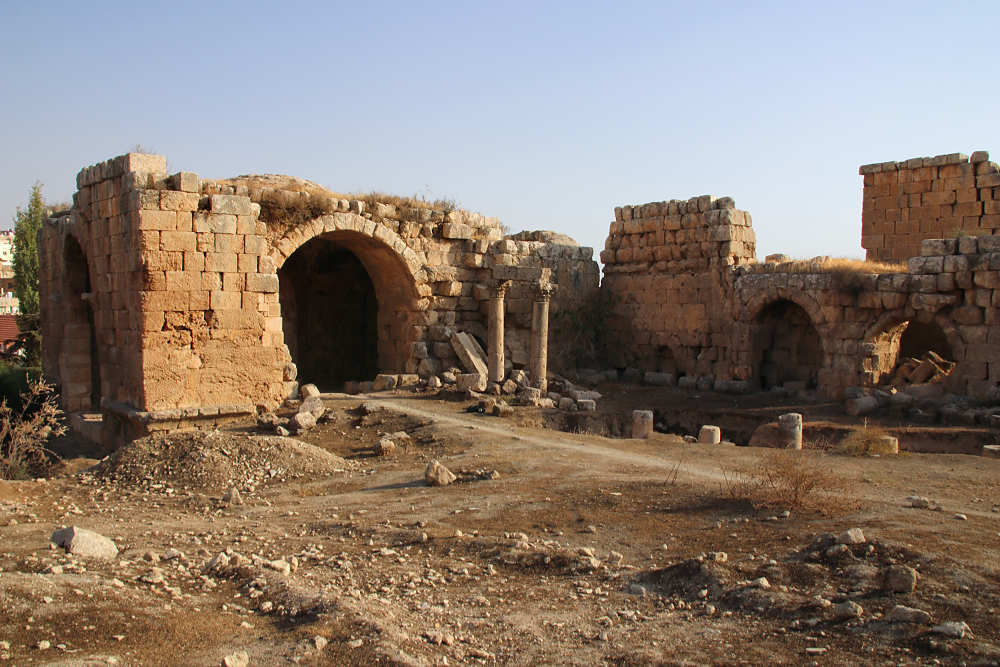- ENDEES
- UiU - Home
- Art Destination Jordan
- AD Jordan
- HIGHLIGHTS
- THEMES
- ITINERARIES
- Travel tips & information
- Free Newsletter
- UiU - Sections
- Free Newsletter
For an optimal view of our website, please rotate your tablet horizontally.
The remains of an architectural complex on the right side of the Cardo, before this main road of Gerasa intercepts the Northern Decumanus, caught the attention of the first researchers already in the 19th century. Through their drawings we can realize that what they saw is quite similar to what we can observe today.
The monumental walls and arches emerging from a mass of debris belong to a thermal complex known as "West Baths" for their location West of the Chrysorhoas (Jerash Wadi). Its basic structure was set up in the northern quarter of Gerasa earlier than the first construction phase of the Cardo and the city's North Gate, whose inscription date this phase as of 115 AD. The monumental expansion of the West Baths was reached during the large-scale urban restructuring of Gerasa from 160 AD onwards.

The thermal building consists of five architectural ensembles, symmetrically organized along an East-West axis which were built from large, regularly layered limestone blocks with sharp joints. The northern chamber is absolutely worth a visit: It is the best preserved space and its dome is the oldest in situ example of this type of stone roofing in the world.

Dome on pendentives of the north chamber. In the background, the Tetrapylon marking the junction between the Cardo and the Northern Decumanus.
While the exterior of this chamber is quadrangular, the interior has a cruciform plan. The load-bearing structure consists of four large pillars that measure 4.75 m on each side and serve not only as buttresses for the vaults that span over four sides of the room, but also for the pendentives(triangular transition segments) that support the cupola of 6.60 m diameter.
This dome on pendentives that is still in place and has not undergone any repair or consolidation since the building was abandoned, is a true masterpiece.


The domed roof once covering the large central hall must have been even more impressive. Its construction over a diameter of almost 20 m from large stone blocks laid in sharp joints, which is proved by the keystones found by the archaeologists in situ, seems unimaginable today.

The remains of the West Baths, seen from the South.
Occupying an area of about 1800 m², a vast U-shaped courtyard space extended the thermal building to the eastern limit of the Cardo. In front of the north domed chamber one can see two columns (of 62 cm diameter) with Corinthian capitals under a monolithic architrave. They are the only remaining ones belonging to the four colonnades that used to embellish the courtyard.

Corinthian columns of the courtyard colonnades

West Baths Sketch Plan by C. S. Fisher from A. St. J. Harrison, published in Kraeling
Thermae were facilities for bathing, the Romans considered essential for maintaining good health. Most Roman cities had at least one. In the case of Gerasa, in addition to these West Baths, there were also the Eastern Baths on the other side of the river, and those in Birketein, a cultic site about 1.5 km north of the city.
Based on the contrast of heat and cold, there were rooms for warming up, sweating, sprinkling, immersion or swimming. A public bath was built around three principal rooms: the tepidarium (warm room), the caldarium (hot room), and the frigidarium (cold room). Although there was a set circuit taken by the bathers allowing them to assure their needs of hygiene and relaxation, they could also personalize their route with a repeated, prolonged and/or shortened frequentation of certain thermal rooms. Since the bathing process took relatively long, and conversation was necessary, it is quite certain that thermae fulfilled also social, civic or political functions.
The triple central hall in the West Baths has been interpreted as the frigidarium, the chamber north with the dome in situ and its symmetrical counterpart in the south, were probably each an apodyterium (undressing room), and the large western hall once covered by a monumental dome, the caldarium. As for the other rooms, scholars' hypotheses differ.

The West Baths, seen from the South. Behind it one can see the columned North Cardo, between the Tetrapylon (left), and the North Gate in the background.
Regarding the water supply of the West baths, unfortunately no archaeological evidence that could inform about it is currently observable. Illustrations and wrtitings by first travelers lead to assume that a small aqueduct passing over the wadi could have led the water from the spring of Aïn Karawan. But the fact that the West Baths are located several meters above the spring, and the absence of material remains does not allow to support this conjecture.
(© Text by Universes in Universe from information in different sources, mainly T. Lepaon, 2012)
West Baths
Jerash Archeological City
Location on map
© Texts and photos are protected by copyright.
Compilation of information, editing, translations, photos: Universes in Universe, unless otherwise indicated
Gerasa, City of the Decapolis.
An account embodying the record of a joint excavation conducted by Yale University and the British School of Archaeology in Jerusalem (1928-1930), and Yale University and the American schools of Oriental Research (1930-1931, 1933-1934).
New Haven, American Schools of Oriental Research, 1938.